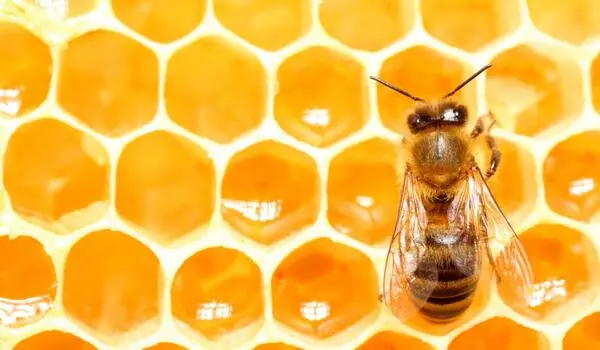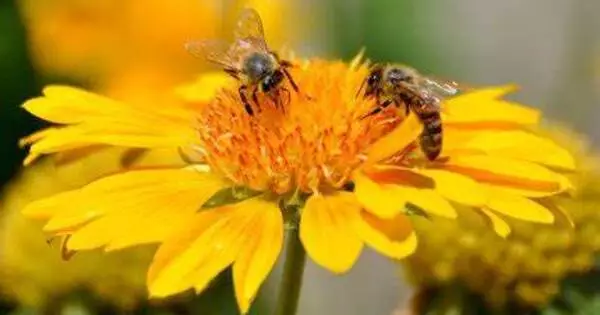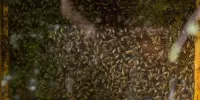Honey bees, like many other social insects, have complex social behaviors that can be influenced by heredity as well as environmental variables. Individuals working for the welfare of the colony rather than their own reproduction are examples of altruism in honey bees.
True altruism in animals is uncommon, but a new study by Penn State researchers discovered that honey bees exhibit this feature. They also discovered that an evolutionary fight of genetics may influence whose parent they acquire it from.
The researchers investigated the genetics of “retinue” behavior in worker honey bees, who are always female, for the study, which was published in the journal Molecular Ecology. After being exposed to the queen bee’s pheromone, worker bees deactivate their own ovaries, aid in the propagation of the pheromone to additional worker bees, and tend to the queen and the eggs she produces.
This is called altruistic behavior because it ultimately enhances the queen’s ability to create offspring while the worker bee remains sterile. The queen of honey bees is normally the mother of all, or almost all, of the bees in the hive.
The researchers discovered that the genes that make worker bees more responsive to this pheromone – and so more prone to exhibit retinue behavior – can be passed along from either the mother or father bees. However, the genes only cause altruistic behavior when they are passed down from the mother.
Honey bees are one of the few animal species that display altruistic behavior, where some individuals give up their own reproduction to help others. This research reveals a very subtle and unexpected type of genetic control over those behaviors.
Sean Bresnahan
According to Sean Bresnahan, corresponding author, doctoral candidate in the Intercollege Graduate Degree Program in Molecular, Cellular, and Integrative Biosciences, and National Science Foundation Graduate Research Fellow, the findings not only provide insight into bee behavior but also show that which parent a bee inherits certain genes from can affect how those genes are expressed, which is notoriously difficult to study in insects.
“People often think about different phenotypes being the result of differences in gene sequences or the environment,” he said. “But what this study shows is it’s not just differences in the gene itself — it’s which parent the gene is inherited from. By the very nature of the insect getting the gene from its mom, regardless of what the gene sequence is, it’s possibly going to behave differently than the copy of the gene from the dad.”
According to Christina Grozinger, co-author and Publius Vergilius Maro Professor of Entomology at Penn State, the finding also supports the Kinship Theory of Intragenomic Conflict, which proposes that the mothers’ and dads’ genes are at odds over which behaviors to support and which to oppose.
While prior research has demonstrated that genes from men can encourage selfish conduct in mammals, plants, and honey bees, she claims that the current study is the first to demonstrate that genes from females can pass on altruistic behavior to their children.

“Honey bees are one of the few animal species that display altruistic behavior, where some individuals give up their own reproduction to help others,” Grozinger said in a statement. “This research reveals a very subtle and unexpected type of genetic control over those behaviors.” We can see in our system that genes from the mother – the queen – promote altruistic behavior in her offspring, resulting in more copies of her genes in the population. Instead of creating their own eggs, worker bees aid in the reproduction of the queen. This research adds to our prior findings that the dads’ genes promote selfish conduct in worker bees, where the bees quit aiding their queen mother and instead focus on their own reproduction.”
The queen mates with multiple males, so worker bees have the same mother but different fathers. Breshnahan explained that this means they share more of their mother’s genes with each other.
“This is why the Kinship Theory of Intragenomic Conflict predicts that genes inherited from the mother will support altruistic behavior in honey bees,” Breshnahan said. “A worker bee benefits more from helping, rather than competing with, her mother and sisters — who carry more copies of the worker’s genes than she could ever reproduce on her own. In contrast, in species where the female mates only once, it is instead the father’s genes that are predicted to support altruistic behavior.”
For the study, the researchers cross-bred six different lineages of honey bees — something that is relatively easy in mammals or plants, according to Bresnahan, but much harder to do with insects. He said the study wouldn’t have been possible without the honey bee breeding expertise of co-author Juliana Rangel at Texas A&M University, as well as Kate Anton who runs the Education about Production and Insemination of (honey bee) Queens program with Robyn Underwood at Penn State Extension.
The researchers investigated the worker bees’ receptivity to the pheromone that prompts the retinue behavior, as well as whether the bees deactivated their ovaries in response to the pheromone once the bee populations were crossed and the progeny were old enough.
“Finally, we used RNA sequencing to look at genome-wide gene expression in the workers, but importantly, we also sequenced the genomes of the parents of those crosses,” Bresnahan said in a statement. “So, we could develop personalized genomes for the parents, and then map back the workers’ gene expression to each parent and find out which parent’s copy of that gene is being expressed.”
Bresnahan stated that they examined gene regulatory networks, or sets of genes regulated by similar transcription factors to cause comparable expression patterns, to try to visualize this battle occurring within the genome. The researchers compared how genes and transcription factors (proteins that turn genes on or off) were expressed from the mother’s copy versus those expressed from the father’s copy to see where one may try to counterbalance the effects of the other.
They were eventually able to uncover gene regulation networks with intragenomic conflict and discovered that more genes were expressed with a parental bias. This maternal- or paternal-originated expression bias is a hallmark of intragenomic conflict, according to the researchers, and it showed more frequently than it would have if the networks had been built with randomly selected genes. Furthermore, these networks included genes that earlier studies has linked to retinue behavior.
















